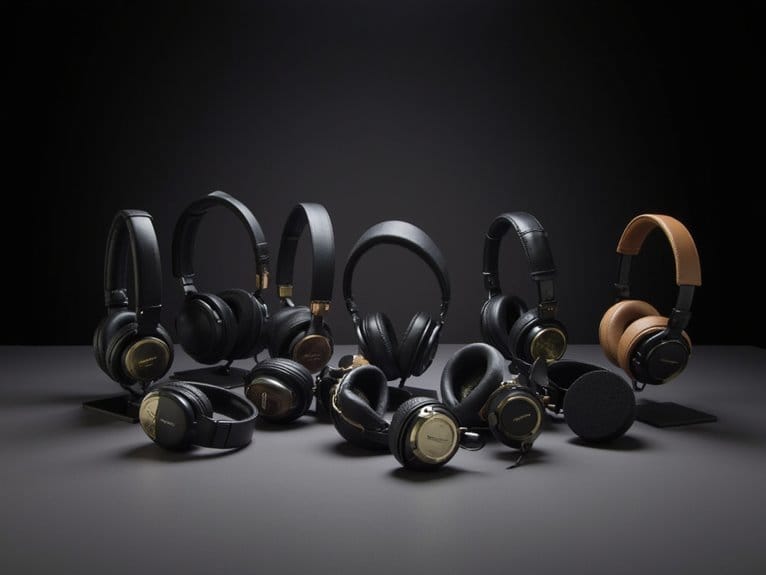Noise Isolation Vs. Noise Cancellation: Selecting the Right Headphones
When choosing between noise isolation and noise cancellation headphones, it’s crucial to understand their distinct technologies. Noise isolation utilizes physical barriers like memory foam to create a seal in the ear canal, effectively reducing external noise levels by 15dB to 30dB. On the other hand, noise cancellation employs advanced circuits and opposing sound waves to block out noises, particularly skilled at reducing low-frequency sounds. Selecting the right headphones involves considering factors like comfort, fit, and sound quality to optimize your listening experience.
We are supported by our audience. When you purchase through links on our site, we may earn an affiliate commission, at no extra cost for you. Learn more.
Understanding Noise Isolation Vs. Noise Cancellation
When comparing noise isolation and noise cancellation in headphones, it is important to understand the distinct mechanisms each employs to reduce unwanted external sounds. Noise isolation relies on physical barriers created by materials like memory foam to block external noise effectively. This passive method does not require power or batteries, making it a cost-effective solution for reducing ambient noise. In contrast, noise cancellation utilizes active technology that involves microphones picking up external sounds and emitting anti-noise signals to counteract them. This active noise cancellation can achieve impressive noise reduction levels of up to 95%, providing users with a highly immersive audio experience.
Sound isolation through memory foam and other isolating technologies forms a seal in the ear canal, preventing external noises from entering. On the other hand, noise cancellation works by actively analyzing external sounds and producing anti-noise signals to cancel them out. The effectiveness of noise isolation can vary but generally reduces noise levels by 15dB to 30dB, while noise cancellation can reach levels of up to 95% external noise blocking. Understanding these mechanisms is important in selecting headphones that cater to individual preferences for ambient noise reduction and audio quality.
Benefits of Noise Isolation Headphones
Noise isolation headphones, like the ones I’ll be discussing, offer improved focus during work by minimizing distractions from ambient noise. Additionally, they enhance audio quality by preventing external sounds from interfering with your listening experience. These benefits make noise isolation headphones a practical choice for those seeking a more immersive and undisturbed audio environment.
Enhanced Focus During Work
Amidst the clamor of a bustling workspace, noise isolation headphones serve as invaluable tools for fostering undisturbed focus and heightened productivity. By blocking distractions and creating a quiet environment, these headphones enhance concentration, allowing users to immerse themselves in tasks without external disturbances. The technology behind noise isolation not only aids in reducing stress and fatigue but also contributes to improved work efficiency. With background noise eliminated, these headphones promote a peaceful and focused work environment.
- Enhancing focus by blocking distractions
- Creating a quiet environment conducive to concentration
- Allowing users to immerse in tasks without disturbances
- Contributing to reduced stress, fatigue, and improved efficiency
Improved Audio Quality
Enhancing audio quality, noise isolation headphones excel at blocking external noise and preventing sound leakage to deliver a superior listening experience. By effectively creating a barrier between the ear and the surroundings, these headphones greatly enhance the clarity of music and depth of sound. The ambient noise reduction capabilities of noise isolation technology provide a more immersive listening experience, allowing for a detailed and undisturbed enjoyment of audio content. These headphones maintain the original sound quality by minimizing interference from external sounds, ensuring a pure and precise audio output. The precise fit of noise isolation headphones plays an important role in preventing sound distortion, contributing to an enhanced audio quality that is free from disruptions.
Advantages of Noise Cancellation Technology
When seeking peak audio immersion, the utilization of noise cancellation technology presents a pivotal advantage in eliminating external disturbances for seamless listening experiences. Noise cancellation technology operates by generating opposing sound waves to counter and nullify unwanted sounds, allowing for uninterrupted listening. This technology is highly effective in establishing an immersive listening environment by efficiently eliminating background noises that may disrupt the audio experience. Noise-canceling headphones enhance the overall listening experience by enabling users to focus solely on the audio without being distracted by external sounds, resulting in a better overall auditory experience.
- Noise cancellation technology creates opposing sound waves to nullify unwanted sounds for uninterrupted listening.
- It helps in creating a peaceful, immersive listening environment by eliminating external noises effectively.
- Noise-canceling headphones enhance focus on audio by blocking out background noises for a superior listening experience.
- They are ideal for protecting hearing from loud noises and enjoying music in loud scenarios.
Moreover, noise cancellation technology plays a vital role in safeguarding one’s hearing health. By reducing exposure to loud noises, it aids in preventing tinnitus symptoms and potential eardrum damage that can occur from prolonged exposure to high decibel levels.
How Noise Isolation Works
Noise isolation technology functions by creating a physical barrier using specialized materials like memory foam to effectively block out external noise. By utilizing high-quality ear tips and ergonomic designs, noise isolation aims to seal the ear canal tightly, preventing unwanted sound from entering. This snug fit not only enhances comfort but also plays an important role in enhancing the effectiveness of passive noise reduction.
Unlike noise cancellation, noise isolation does not rely on electronics or microphones to block out external noise. Instead, it focuses on the design and materials of the headphones themselves. The use of memory foam, for instance, helps in creating a tight seal around the ear, which aids in blocking external noise effectively.
The key to successful noise isolation lies in the combination of design and materials. Headphones designed with noise isolation in mind often feature ear tips that come in various sizes to guarantee a proper fit for different ear shapes. Additionally, the ergonomic design of these headphones contributes to a comfortable wearing experience while maximizing the isolation of external noise. Ultimately, noise isolation technology excels in providing passive noise reduction through the use of quality materials and a well-engineered design.
Exploring Noise Cancellation Mechanisms
Utilizing sophisticated microphones and intricate circuits, noise canceling headphones employ cutting-edge technology to detect and counter external noises through the generation of anti-noise signals. The anti-noise signals produced create opposing sound waves that effectively cancel out background noise, providing users with a peaceful and immersive listening experience. Here are some key mechanisms behind noise cancellation:
- Detection of External Noises: Noise canceling headphones use built-in microphones to capture external sounds in the environment.
- Generation of Anti-Noise Signals: Advanced circuits process the captured sound data to produce anti-noise signals that mirror the unwanted noise.
- Creation of Opposing Sound Waves: The anti-noise signals are then emitted by the headphones’ speakers to generate opposing sound waves that cancel out the external noises.
- Reduction of Low-Frequency Sounds: Noise canceling technology is particularly effective at reducing low-frequency sounds, such as the hum of engines or air conditioning units, for an ideal listening experience.
Factors to Consider When Choosing
When choosing headphones, two important factors to think about are sound quality comparison and comfort and fit. Sound quality comparison involves evaluating the audio performance of noise-canceling and noise isolating headphones to determine the clarity, depth, and balance of sound reproduction. Comfort and fit play a significant role in the overall listening experience, ensuring that the headphones are comfortable to wear for extended periods and provide a secure seal for best noise isolation.
Sound Quality Comparison
Enhancing the listening experience involves considering various factors that contribute to sound quality in both noise-canceling and noise isolating headphones.
- Active technology in noise-canceling headphones cancels external noise, enhancing immersive listening.
- Noise isolating headphones use physical barriers to block external noise for focused listening.
- Driver size, frequency response, and audio codecs impact sound quality in both types of headphones.
- Noise-canceling headphones excel in sound quality by eliminating distractions and creating a serene listening environment.
Comfort and Fit
Consideration of comfort and fit is essential when selecting between noise isolation and noise cancellation headphones to guarantee prolonged wearability without compromising user experience. The snug fit required for noise isolation headphones helps create a seal for effective noise reduction. In contrast, noise cancellation headphones need a comfortable fit to optimize the noise cancellation technology. Properly fitting ear tips in noise isolating headphones can enhance passive noise reduction and overall comfort. Incorrectly fitted noise-canceling headphones may lead to discomfort, affecting the efficiency of noise cancellation. Evaluating the design and ergonomics of the headphones is vital in determining the level of comfort and fit that align with the user’s preferences. Proper fit plays a critical role in ensuring the desired noise isolation or cancellation performance.







